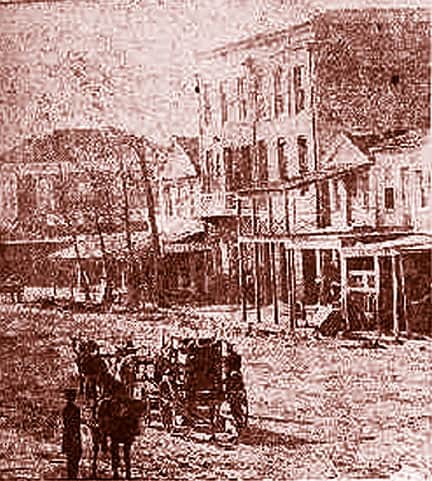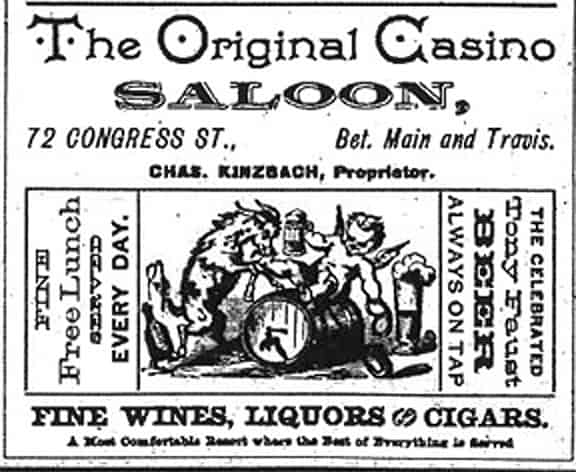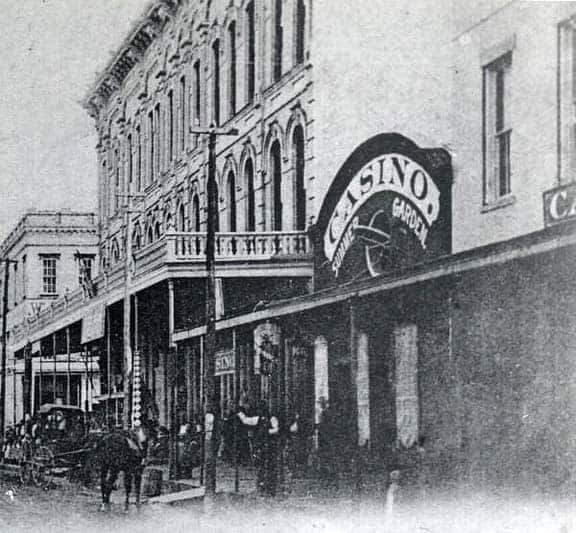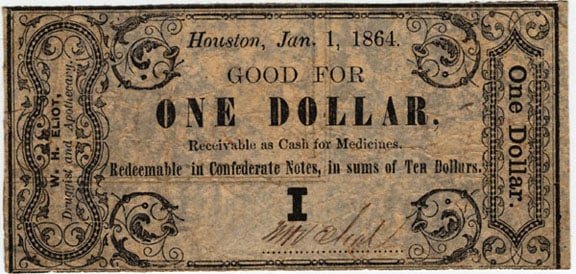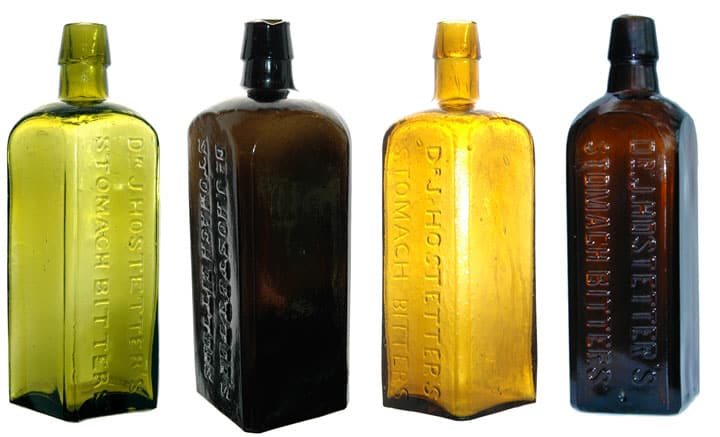What was here, Early Houston Advertisements – Part II
04 April 2013
U N D E R M Y F E E T
![]() Yesterday I started a series about ‘looking in my own back yard’ for Texas history relating to the bottles we collect. You see, I live in Houston, aka “Bayou City”. Read: Allen’s Landing – Houston (not everything is new here) – Part I I know I am not going to discover a Houston Glass Works or rows of houses and privies from the late 18th or early to mid 19th century but I want to see what is, in reality, under my feet. I mean, somewhere here downtown, there had to have been recycling plants, warehouses and dumps for the medicine and liquor that was available to the early Houston settlers, railroad workers, cotton exporters and wheelers and dealers. Houston is now a city on an old city. Everything, just about, has been covered up.
Yesterday I started a series about ‘looking in my own back yard’ for Texas history relating to the bottles we collect. You see, I live in Houston, aka “Bayou City”. Read: Allen’s Landing – Houston (not everything is new here) – Part I I know I am not going to discover a Houston Glass Works or rows of houses and privies from the late 18th or early to mid 19th century but I want to see what is, in reality, under my feet. I mean, somewhere here downtown, there had to have been recycling plants, warehouses and dumps for the medicine and liquor that was available to the early Houston settlers, railroad workers, cotton exporters and wheelers and dealers. Houston is now a city on an old city. Everything, just about, has been covered up.
Read Part IIA – What was here, Early Houston Advertisements – Part IIA
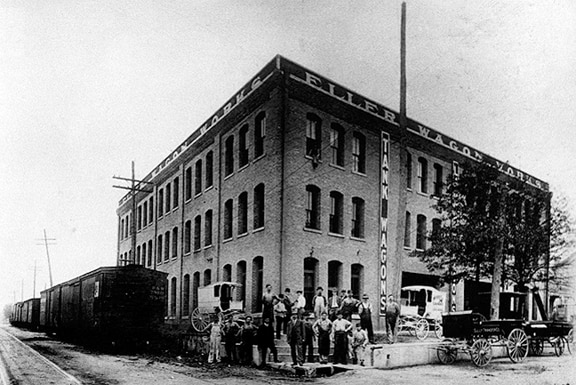 I have lived and worked downtown since 1983 and know quite a bit about how to navigate the complex roadways, pathways, railroad right-of-ways and bayou paths. That is the great thing about being a runner (actually jogger as I get older) and a dog walker. We have eight dogs here at our office on the corner of Crawford and Commerce Streets. The building pictured above is a historical photograph of the Eller Wagon Works Building where we have about 5,000 sq ft of studio space on the dock level, first floor. My space is the three windows on each side of the corner behind the workers. Read more about FMG.
I have lived and worked downtown since 1983 and know quite a bit about how to navigate the complex roadways, pathways, railroad right-of-ways and bayou paths. That is the great thing about being a runner (actually jogger as I get older) and a dog walker. We have eight dogs here at our office on the corner of Crawford and Commerce Streets. The building pictured above is a historical photograph of the Eller Wagon Works Building where we have about 5,000 sq ft of studio space on the dock level, first floor. My space is the three windows on each side of the corner behind the workers. Read more about FMG.
S H O C K E R U P T H E S T R E E T
Last year I did a post on St. Nicholas Stomach Bitters and was surprised to find out that cases of the stuff were, at some much earlier time, sitting close to my office. Probably off-loaded right at Allen’s Landing. This led me today to look at what else was being pushed and sold in early Houston. That is the topic of today’s post.
 Bitters – 200 cases of St. Nicholas Stomach Bitters, 50 cases Stouten’s | 50 cases Hostetters, 49 Turners Forest Wine”
Bitters – 200 cases of St. Nicholas Stomach Bitters, 50 cases Stouten’s | 50 cases Hostetters, 49 Turners Forest Wine”
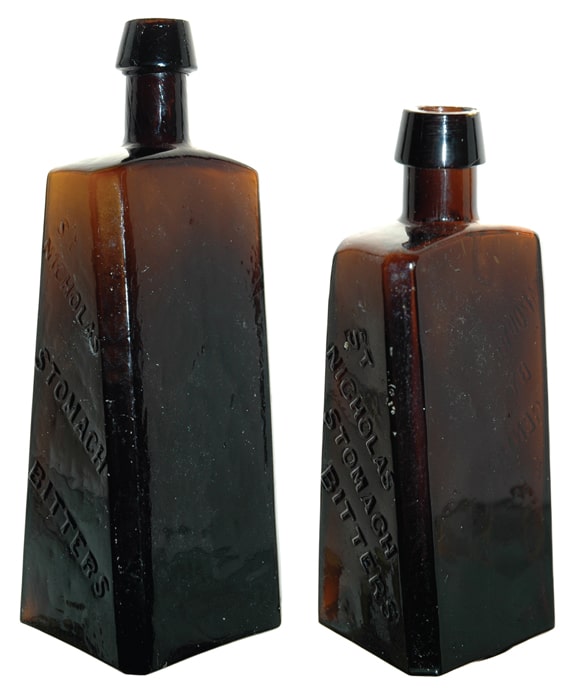
The large and small size of the pontiled ST. NICHOLAS STOMACH BITTERS (These bitters were being sold in Houston) – Meyer Colection
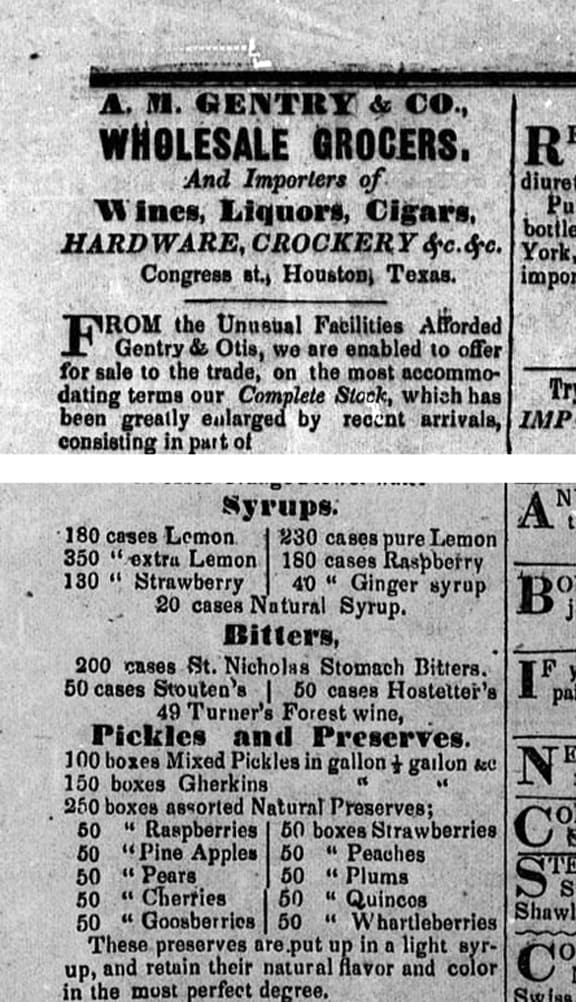
Here is an advertisement from the Southern Democrat. (Waco, Texas), Vol. 1, No. 39, Ed. 1 Thursday, November 18, 1858. Wow…200 cases of ST. NICHOLAS STOMACH BITTERS and 50 cases of HOSTETTER’S STOMACH BITTERS sitting blocks from where I am sitting now.
J U L Y 8, 1 8 6 9 – H O U S T O N
 the issue for April 14 was being readied when publication was again interrupted by the Mexicans, who captured the printers and threw the press into Buffalo Bayou.
the issue for April 14 was being readied when publication was again interrupted by the Mexicans, who captured the printers and threw the press into Buffalo Bayou.
TELEGRAPH AND TEXAS REGISTER
The Telegraph and Texas Register, later variously known as the weekly, tri-weekly, or daily Telegraph, was the first newspaper in Texas to achieve a degree of permanence. The paper was begun on October 10, 1835, at San Felipe de Austin by Gail Borden, Jr., Thomas H. Borden, and Joseph Baker. It became the official organ of the Republic of Texas, which was organized a few months later. By December 14 the paper claimed a circulation of 500. The advance of Antonio López de Santa Anna’s force compelled the publishers to retire after issuing their paper on March 24, 1836. On April 5 Baker withdrew from the firm to join the army. The press was removed to Harrisburg, and the issue for April 14 was being readied when publication was again interrupted by the Mexicans, who captured the printers and threw the press into Buffalo Bayou. Texas State Historical Association
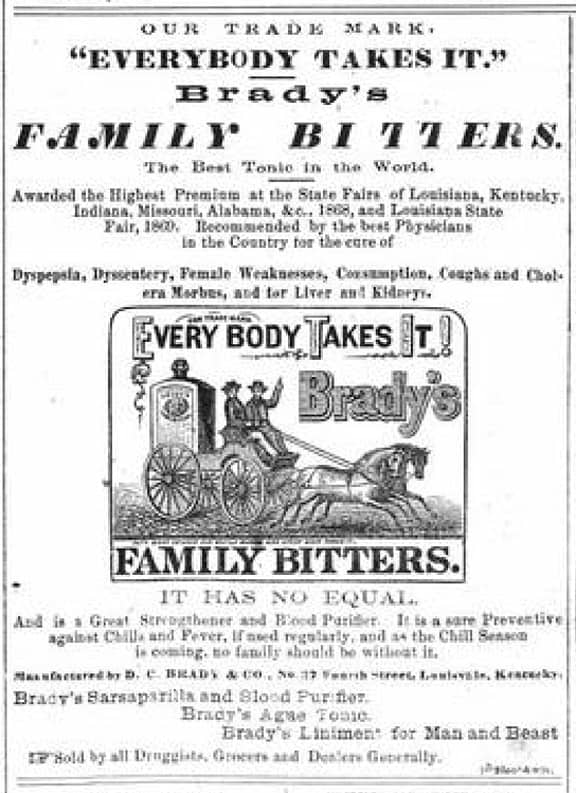
Brady’s Family Bitters advertisement (see examples below) – The Houston Telegraph, Thursday, July 8, 1869
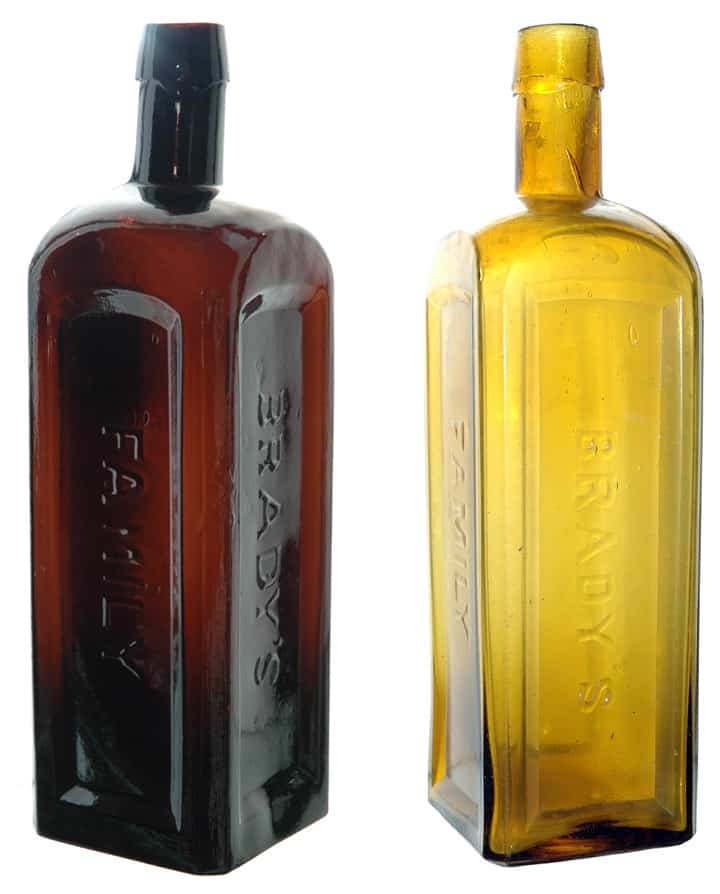
BRADY’S FAMILY BITTERS in two colors. Product being sold in Houston in 1869 (see advertisement above). – Meyer Collection
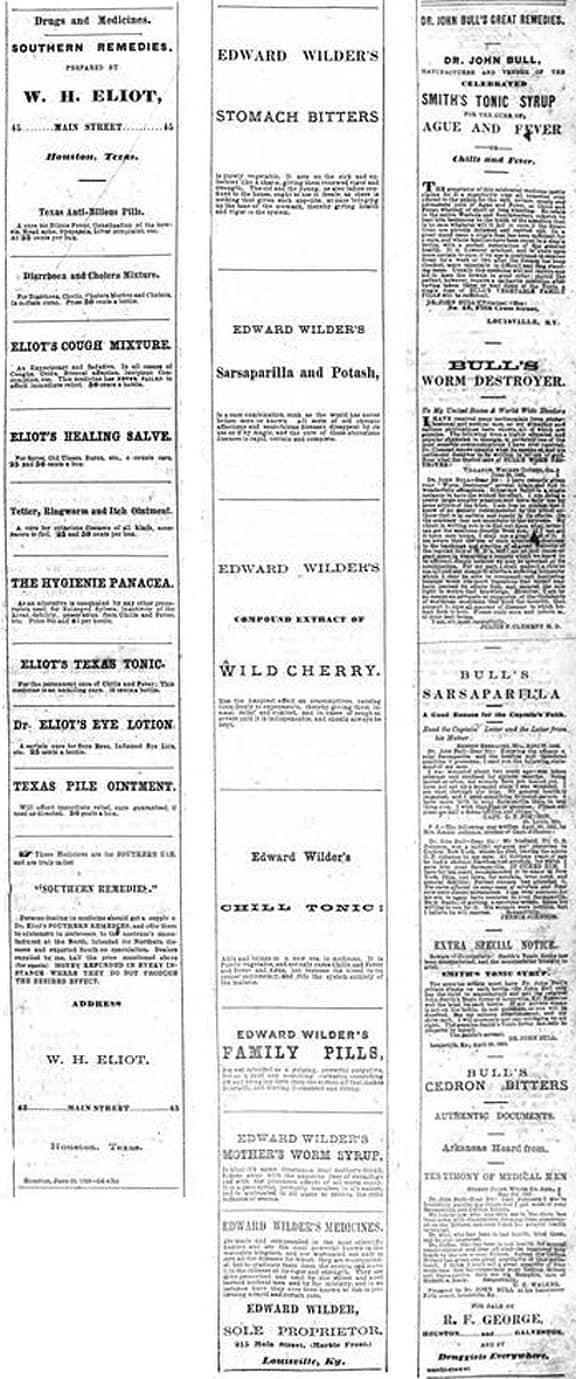
Three very tall, single column, medicine advertisements in The Houston Telegraph, Thursday, July 8, 1869. Products from W. H. Eliot, Edward Wilder and Dr. John Bull.
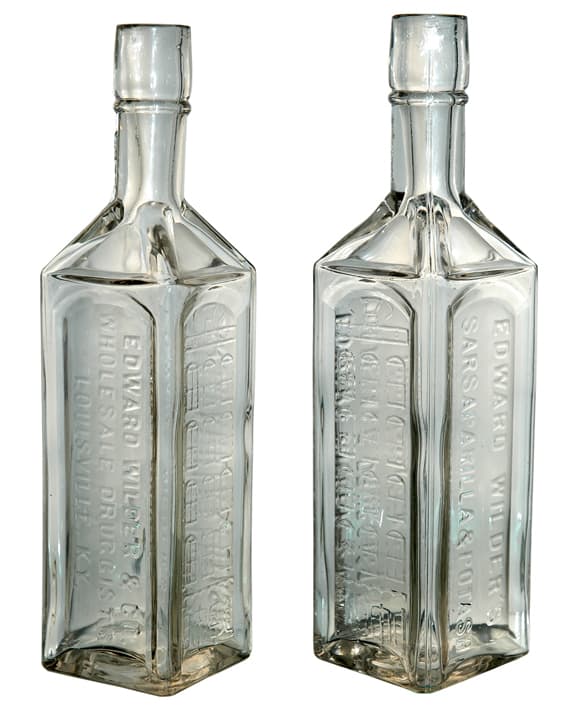
EDWARD WILDER’S SARSAPARILLA & POTASH being sold in Houston in 1869 (see advertisement above) – Meyer Collection
Read More: Edward Wilder and his Building Bottles
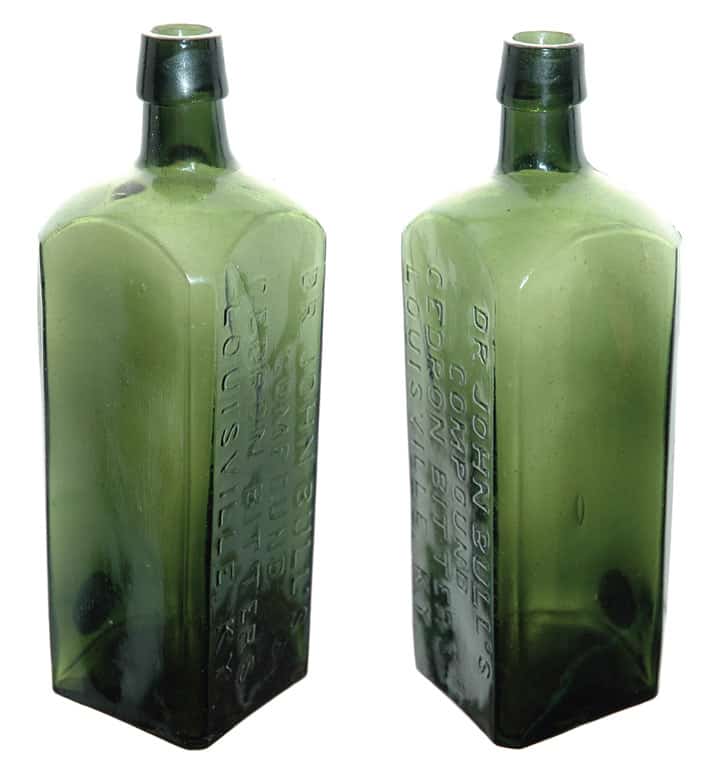
DR. JOHN BULL’S COMPOUND CEDRON BITTERS sold in Houston (see advertisements above and below) – Meyer Collection
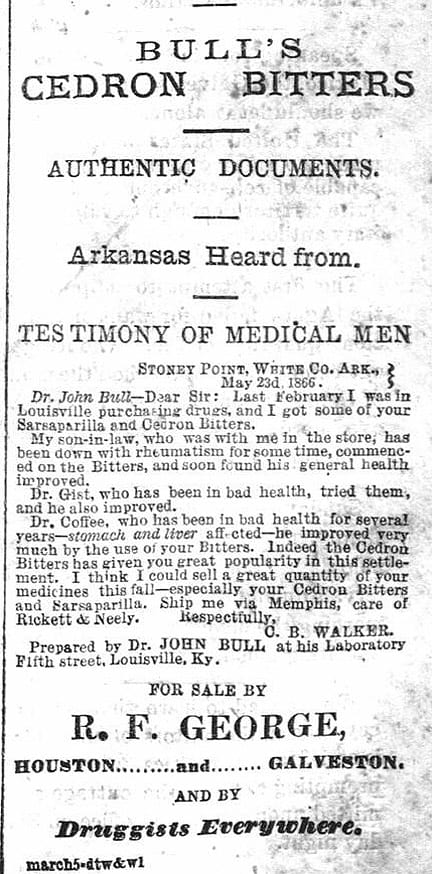
Bull’s Cedron Bitters advertisement for sale by R. F, George Houston and Galveston. (see example above) – The Houston Telegraph, Thursday, July 8, 1869
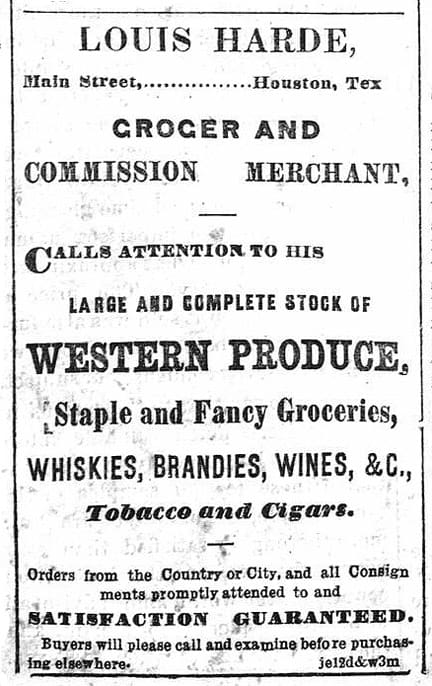
Advertisement for Louis Harde Grocer and Commission Merchant, Main Street, Houston – The Houston Telegraph, Thursday, July 8, 1869
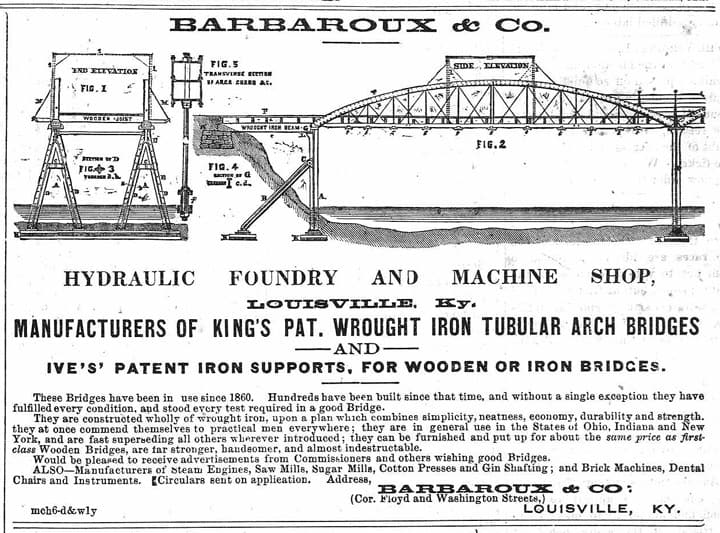
Barbaroux & Co bridge builder advertisement. Interesting ad placement in Houston with all of the train bridges over the bayous and rivers. – The Houston Telegraph, Thursday, July 8, 18
T H E O R I G I N A L C A S I N O
S A L O O N
C O N C L U S I O N
As I suspected. This simple exercise tells me that this town was loaded with medicine, bitters and alcohol. I just need to dig deeper. Who knows, maybe some of my Wilder, Hostetter or John Bull bottles were once in Houston! Next in Part III we will deal with clues and paths.
Read more:
Stagecoach Stops and Bartletts Excelsior Bitters
The two embossed TEXAS Bitters
St. Nicholas Stomach Bitters – Gentry & Otis – New, York

